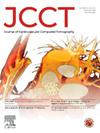CCTA 和 CTP 成像对临床疑似支架内再狭窄的诊断性能:荟萃分析
IF 5.5
2区 医学
Q1 CARDIAC & CARDIOVASCULAR SYSTEMS
引用次数: 0
摘要
目的:本研究旨在进行一项荟萃分析,评估冠状动脉计算机断层扫描血管造影术(CCTA)和在CCTA基础上结合计算机断层扫描灌注术(CTP)的混合方法(CCTA + CTP)在检测血管造影定义的支架内再狭窄(ISR)方面的诊断性能:方法:对文章进行全面检索,共发现 18,513 项研究。在去除重复、标题/摘要筛选和全文审阅后,纳入了 17 项 CCTA 和 3 项 CCTA + CTP 研究。只有使用≥64切片多载体计算机断层扫描(CT)的研究才符合条件:结果:每位患者的 ISR 发生率为 43%,其中 92% 的支架可通过 CCTA 完全解读。元分析显示,每个支架的 CCTA(n = 2674)灵敏度为 90 %(95 % CI;84-94 %),特异性为 89 %(95 % CI;86-92 %),阳性似然比为 7.17(95 % CI;5.24-9.61),阴性似然比为 0.17(95 % CI;0.10-0.25),诊断几率比为 45.7(95 % CI;22.71-82.43)。其他敏感性分析显示,支架直径或支架厚度对 CCTA 的诊断率没有影响。与CCTA相比,CCTA + CTP(n = 752)对每个支架的诊断效果没有差异:结论:利用目前使用的扫描仪,CCTA 和 CCTA + CTP 在评估支架内再狭窄方面具有很高的诊断性能。因此,既往支架植入史不应成为临床疑似患者不使用这些方法的理由。本文章由计算机程序翻译,如有差异,请以英文原文为准。

Diagnostic performance of CCTA and CTP imaging for clinically suspected in-stent restenosis: A meta-analysis
Aims
The objective of this study is to conduct a meta-analysis to assess the diagnostic performance of Coronary Computed Tomography Angiography (CCTA) and a hybrid approach that incorporates Computed Tomography Perfusion (CTP) in addition to CCTA (CCTA + CTP) for the detection of in-stent restenosis (ISR), as defined by angiography.
Methods
A comprehensive search of articles identified 18,513 studies. After removing duplicates, title/abstract screening, and full-text review, 17 CCTA and 3 CCTA + CTP studies were included. Only studies using ≥64-slices multidetector computed tomography (CT) were considered eligible.
Results
The per-patient ISR prevalence was 43 %, with 92 % of stents fully interpretable with CCTA. Meta-analysis exhibited a per-stent CCTA (n = 2674) sensitivity of 90 % (95 % CI; 84–94 %), specificity of 89 % (95 % CI; 86–92 %), positive likelihood ratio of 7.17 (95 % CI; 5.24–9.61), negative likelihood ratio of 0.17 (95 % CI; 0.10–0.25), and diagnostic odds ratio of 45.7 (95 % CI; 22.71–82.43). Additional sensitivity analyses revealed no influence of stent diameter or strut thickness on the diagnostic yield of CCTA. The per-stent diagnostic performance of CCTA + CTP (n = 752) did not show differences compared to CCTA.
Conclusions
With currently utilized scanners, CCTA and CCTA + CTP demonstrated high diagnostic performance for in-stent restenosis evaluation. Consequently, a history of previous stent implantation should not be an argument to preclude using these methods in clinically suspected patients.
求助全文
通过发布文献求助,成功后即可免费获取论文全文。
去求助
来源期刊

Journal of Cardiovascular Computed Tomography
CARDIAC & CARDIOVASCULAR SYSTEMS-RADIOLOGY, NUCLEAR MEDICINE & MEDICAL IMAGING
CiteScore
7.50
自引率
14.80%
发文量
212
审稿时长
40 days
期刊介绍:
The Journal of Cardiovascular Computed Tomography is a unique peer-review journal that integrates the entire international cardiovascular CT community including cardiologist and radiologists, from basic to clinical academic researchers, to private practitioners, engineers, allied professionals, industry, and trainees, all of whom are vital and interdependent members of our cardiovascular imaging community across the world. The goal of the journal is to advance the field of cardiovascular CT as the leading cardiovascular CT journal, attracting seminal work in the field with rapid and timely dissemination in electronic and print media.
 求助内容:
求助内容: 应助结果提醒方式:
应助结果提醒方式:


